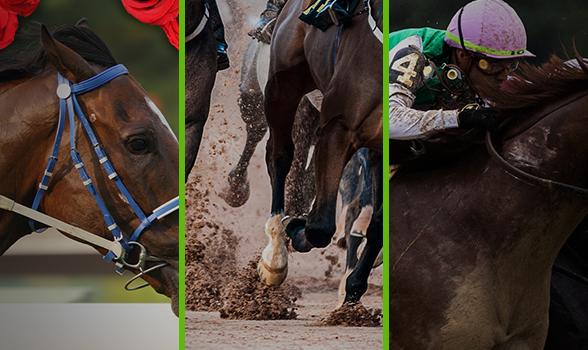
Triple Crown Races

Triple Crown Races
The highest achievement in all of horse racing, winning the Triple Crown is one of the rarest feats in all of sports. To win the Triple Crown, a horse must win three of the most competitive races in America over a span of five weeks. To compete, the horses must be three-year-old Thoroughbreds, which means no horse can win the prize more than once. The allure of the Triple Crown and the immortality that comes with it attracts many of the best horses, jockeys, and trainers from around the world every year.

What Are the Triple Crown Races?
The Triple Crown consists of three highly competitive races, all of different lengths. The three Triple Crown horse races are:
The Kentucky Derby
The opening race of the Triple Crown, the winner of the Kentucky Derby is the only horse with a chance at the Crown that year. It is held the first Saturday in May at Churchill Downs in Louisville, Kentucky. The Kentucky Derby is one and a quarter miles long and known for its festivities surrounding the event—many attendees come dressed in elaborate outfits and hats, and enjoy the traditional mint julep cocktail.
The Preakness Stakes
Run at Pimlico Race Course in Baltimore, Maryland, the Preakness Stakes was named after the inaugural winner, Preakness, who won in 1873. It is one of the oldest races in the United States and the middle jewel of the Triple Crown of Thoroughbred Racing, sandwiched between the Kentucky Derby and Belmont Stakes. The Preakness is the shortest of the Triple Crown tracks at one and 3/16 miles, favoring speed and strength. The legendary jockey, Eddie Arcaro, won the Preakness an astounding six times.
The Belmont Stakes
The Belmont Stakes is one of the premiere races in America. It takes place at Belmont Park, located in Elmont, New York (near New York City). The Belmont Stakes is one of the oldest races in the United States, run annually ever since its inaugural race back in 1867. The Belmont is the final leg of the Triple Crown, so if a horse has won the first two races, the Belmont is the only thing standing between them and history.
If you’ve ever wondered what is the Triple Crown’s toughest race, most consider it to be the Belmont—for both horses and jockeys alike. One reason for this is the length (one and a half miles), which makes it the longest track of the Triple Crown. The race is a global event, watched by millions around the world and typically attended by nearly 100,000 attendees. If a horse has a shot at the Triple Crown, the number of viewers and attendees goes way up in hopes of witnessing the glory.
History of Triple Crown winners
The Triple Crown remains one of the most elusive achievements in all of sports. How many horses have won the Triple Crown? By 2022, only thirteen horses accomplished the feat. This is over a nearly 150 year span, as all three races have been simultaneously in existence as of 1875.
The winners of the Triple Crown are:
Sir Barton (1919)
Gallant Fox (1930)
Omaha (1935)
War Admiral (1937)
Whirlaway (1941)
Count Fleet (1943)
Assault (1946)
Citation (1948)
Secretariat (1973)
Seattle Slew (1977)
Affirmed (1978)
American Pharaoh (2015)
Justify (2018)
Why is it so difficult to win the Triple Crown?
The Triple Crown is one of the most difficult accomplishments in not only horse racing, but all of sports. There are a few factors that make it particularly tough to do.
First, many horse owners are cautious. It’s understandable when you think of the financial investment that goes into a top racehorse—from purchase to boarding, training, transportation, vet bills, and all other expenses. Plus, there’s potentially millions of dollars on the line in breeding income after the horse’s racing career.
It is also uncommon for a horse to race in all three Crown races. A horse that goes for the Triple Crown will be racing against fresher horses who haven’t been on the road racing for the last several weeks straight. This added rest can play a huge role in the race’s outcome. To go for the Triple Crown involves a great deal of strain, mentally and physically, since it’s a lot of racing in a short period of time. A horse that becomes injured along the way may cost an owner a great deal of money.
Another factor is the length of the races. Not all of them are the same distance, which means different horses can have an advantage, depending on their strengths and the race. The Belmont Stakes is quite long at one and a half miles—in fact, it’s the longest stakes race any of the horses will run in North America.
So, coming off of less rest than many of their competitors, a Triple Crown candidate has to run the longest race of its life in order to make history. Add to this the fact that sprinting is considered the highest valued trait, which means a horse that wins the first two Triple Crown legs probably hasn’t been focused as much on training for the longer distance races.
History of the Triple Crown
The pursuit of the Triple Crown has led to many exhilarating and heartbreaking finishes over its long history. Here are just a few of the many highlights.
Historic races
- Perhaps the most memorable and breathtaking finish to a Triple Crown attempt is also the most soul crushing. In 1998, Real Quiet had completed two-thirds of the Crown with wins at the Kentucky Stakes and Preakness. With a large lead and less than a furlong to go, Victory Gallop began to push for the comeback. The result was a photo finish and maybe the most dramatic end to a horse race ever. In the end, Victory Gallop one by an inch and Real Quiet was robbed of a place in the record books as a Triple Crown winner.
- Secretariat might very well be the greatest Triple Crown winner horse of all time. He not only won the Triple Crown, he won it in fashion. He destroyed the field at the Belmont, winning by 31 lengths, and setting a new track record of 2:24.00.
- 2005 saw another dramatic finish, this time at the Preakness Stakes. Afleet Alex made a push on the final turn, where the leader, Scrappy T, went wide causing the two horses to clip heels. Afleet nearly went down and his jockey, Jeremy Rose, almost fell out of the saddle. Rider and horse regained control and went on to win the race.
- The Kentucky Derby of 1933 got... feisty. Known as the “fighting finish,” the two jockeys battling for the win were physically fighting with each other atop their horses. Brokers Tip and his rider, Don Meade, ultimately won the race against Herb Fisher and his horse Head Play. The two continued their altercation later in the jockey’s room.
- A horse as great as Secretariat deserves to make this list twice. Although Secretariat’s Triple Crown-clinching Belmont run is his most famous race, the horse known as Big Red foreshadowed that win with his victory at the Preakness. He made a move around the first bend and never looked back. His jockey, Ron Turcotte, never even used his whip. Now that’s domination.
Interesting facts about the Triple Crown
The Triple Crown has a long and rich history. Here are some interesting facts about it:
- 1875 marked the first time that all three Triple Crown races were run in the same year.
- The winning horse of the Kentucky Derby is draped in a blanket of roses, which is why it is also known as the Run for the Roses.
- The Triple Crown trophy wasn’t first awarded until 1950. It is a three sided vase design made of silver, commissioned by the Thoroughbred Racing Association. It was first awarded to the 1948 Triple Crown winner: Citation. Each year after, the trophy was awarded retroactively to each previous winner in reverse order, until it was awarded to each previous winner or their heirs.
- The longest drought between wins was after Affirmed was the last Triple Crown winner of the 20th Century (1978). It wasn’t won again until American Pharaoh took the title in 2015.
- No filly (female horse) has ever won the Triple Crown. Rags to Riches won the Belmont in 2007, breaking over a century drought for filly horses in the event.
- 2020 was the first time the Belmont was the first race of the Triple Crown due to delays from the Covid-19 pandemic.
- The only jockey to win the Triple Crown twice was Eddie Arcaro, in 1941 and 1948.
- Many wonder, did Seabiscuit win the Triple Crown? The answer is no. Seabiscuit had his best years after his three-year-old season, so didn’t run the Triple Crown.
